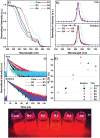Cadmium-Doped Zinc Sulfide Shell as a Hole Injection Springboard for Red, Green, and Blue Quantum Dot Light-Emitting Diodes
- PMID: 35240001
- PMCID: PMC9131609
- DOI: 10.1002/advs.202104488
Cadmium-Doped Zinc Sulfide Shell as a Hole Injection Springboard for Red, Green, and Blue Quantum Dot Light-Emitting Diodes
Abstract
A new strategy is developed in which cadmium-doped zinc sulfide (CdZnS) is used as the outermost shell to synthesize red, green, and blue (RGB) quantum dots (QDs) with the core/shell structures of CdZnSe/ZnSe/ZnS/CdZnS, CdZnSe/ZnSe/ZnSeS/CdZnS, and CdZnSe/ZnSeS/ZnS/CdZnS, respectively. Firstly, the inner ZnS and ZnSe shells confine the excitons inside the cores of QDs and provide a better lattice matching with respect to the outermost shell, which ensures high photoluminescence quantum yields of QDs. Secondly, the CdZnS shell affords its QDs with shallow valence bands (VBs). Therefore, the CdZnS shell could be used as a springboard, which decreases the energy barrier for hole injection from polymers to QDs to be below 1.0 eV. It makes the holes to be easily injected into the QD EMLs and enables a balanced recombination of charge carriers in quantum dot light-emitting diodes (QLEDs). Thirdly, the RGB QLEDs made by these new QDs exhibit peak external quantum efficiencies (EQEs) of 20.2%, 19.2%, and 8.4%, respectively. In addition, the QLEDs exhibit unexpected luminance values at low applied voltages and therefore high power efficiencies. From these results, it is evident that CdZnS could act as an excellent shell and hole injection springboard to afford high performance QLEDs.
Keywords: balanced charge carriers; efficient quantum dot light-emitting diodes; high photoluminescence quantum yields; hole injection springboard; outermost CdZnS shell.
© 2022 The Authors. Advanced Science published by Wiley-VCH GmbH.
Conflict of interest statement
The authors declare no conflict of interest.
Figures







References
-
- Moon H., Lee C., Lee W., Kim J., Chae H., Adv. Mater. 2019, 31, 1804294. - PubMed
-
- Yang Z., Gao M., Wu W., Yang X., Sun X. W., Zhang J., Wang H.‐C., Liu R.‐S., Han C.‐Y., Yang H., Li W., Mater. Today 2019, 24, 69.
-
- Dai X., Deng Y., Peng X., Jin Y., Adv. Mater. 2017, 29, 1607022. - PubMed
-
- Cho H., Pan J.‐A., Wu H., Lan X., Coropceanu I., Wang Y., Cho W., Hill E. A., Anderson J. S., Talapin D. V., Adv. Mater. 2020, 32, 2003805. - PubMed
-
- Nannen E., Frohleiks J., Gellner S., Adv. Funct. Mater. 2020, 30, 1907349.
Publication types
MeSH terms
Substances
Grants and funding
- 21901190/National Natural Science Foundation of China
- 2020B010174004/Key-Area Research and Development Program of Guangdong Province
- 2021KCXTD042/College Innovation Team Project of Guangdong Province
- 2019A1515111201/Guangdong Basic and Applied Basic Research Foundation
- 2019A1515110778/Guangdong Basic and Applied Basic Research Foundation
- 2020B0101030008/Science and Technology Planning Project of Guangdong Province
- 2021ZZ201/Fujian Science & Technology Innovation Laboratory for Optoelectronic Information of China Project Program
- 2017KSYS011/Key Laboratory of Optoelectronic materials and Applications in Guangdong Higher Education
- PolyU 153062/18P/Hong Kong Research Grants Council
- 2019B121205001/Guangdong-Hong Kong-Macao Joint Laboratory for Photonic-Thermal-Electrical Energy Materials and Devices
- 52073242/National Natural Science Foundation of China
- CAS-Croucher Funding Scheme for Joint Laboratories
- GHP/038/19GD/ITC Guangdong-Hong Kong Technology Cooperation Funding Scheme
- 1-ZE1C/Hong Kong Polytechnic University
- Research Institute for Smart Energy
- 847S/Endowed Professorship in Energy from Miss Clarea Au
LinkOut - more resources
Full Text Sources
Other Literature Sources
